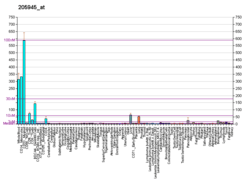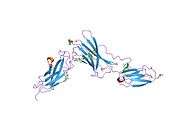Interleukin-6 receptor
Interleukin 6 receptor (IL6R) also known as CD126 (Cluster of Differentiation 126) is a type I cytokine receptor.
Function
Interleukin 6 (IL6) is a potent pleiotropic cytokine that regulates cell growth and differentiation and plays an important role in immune response. Dysregulated production of IL6 and this receptor are implicated in the pathogenesis of many diseases, such as multiple myeloma, autoimmune diseases and prostate cancer.
In melanocytes IL6R gene expression may be regulated by MITF.[5]
Structure
The IL6 receptor is a protein complex consisting of an IL-6 receptor subunit (IL6R) and interleukin 6 signal transducer Glycoprotein 130. IL6R also denotes the human gene encoding this subunit. Alternatively spliced transcript variants encoding distinct isoforms have been reported.[6] IL6R subunit is also shared by many other cytokines.
Interactions
Interleukin-6 receptor has been shown to interact with Interleukin 6[7][8][9] and Ciliary neurotrophic factor.[8][10]
See also
- Cluster of differentiation
- Tocilizumab, a monoclonal antibody against IL6R
- Sarilumab, a monoclonal antibody against IL6R
References
- 1 2 3 GRCh38: Ensembl release 89: ENSG00000160712 - Ensembl, May 2017
- 1 2 3 GRCm38: Ensembl release 89: ENSMUSG00000027947 - Ensembl, May 2017
- ↑ "Human PubMed Reference:".
- ↑ "Mouse PubMed Reference:".
- ↑ Hoek KS, Schlegel NC, Eichhoff OM, Widmer DS, Praetorius C, Einarsson SO, Valgeirsdottir S, Bergsteinsdottir K, Schepsky A, Dummer R, Steingrimsson E (2008). "Novel MITF targets identified using a two-step DNA microarray strategy". Pigment Cell Melanoma Res. 21 (6): 665–76. PMID 19067971. doi:10.1111/j.1755-148X.2008.00505.x.
- ↑ "Entrez Gene: IL6R interleukin 6 receptor".
- ↑ Schwantner A, Dingley AJ, Ozbek S, Rose-John S, Grötzinger J (Jan 2004). "Direct determination of the interleukin-6 binding epitope of the interleukin-6 receptor by NMR spectroscopy". J. Biol. Chem. 279 (1): 571–6. PMID 14557255. doi:10.1074/jbc.M311019200.
- 1 2 Schuster B, Kovaleva M, Sun Y, Regenhard P, Matthews V, Grötzinger J, Rose-John S, Kallen KJ (Mar 2003). "Signaling of human ciliary neurotrophic factor (CNTF) revisited. The interleukin-6 receptor can serve as an alpha-receptor for CTNF". J. Biol. Chem. 278 (11): 9528–35. PMID 12643274. doi:10.1074/jbc.M210044200.
- ↑ Taga T, Hibi M, Hirata Y, Yamasaki K, Yasukawa K, Matsuda T, Hirano T, Kishimoto T (Aug 1989). "Interleukin-6 triggers the association of its receptor with a possible signal transducer, gp130". Cell. 58 (3): 573–81. PMID 2788034. doi:10.1016/0092-8674(89)90438-8.
- ↑ Schooltink H, Stoyan T, Roeb E, Heinrich PC, Rose-John S (Dec 1992). "Ciliary neurotrophic factor induces acute-phase protein expression in hepatocytes". FEBS Lett. 314 (3): 280–4. PMID 1281789. doi:10.1016/0014-5793(92)81489-9.
Further reading
- Krause E, Wegenka U, Möller C, Horn F, Heinrich PC (1992). "Gene expression of the high molecular weight proteinase inhibitor alpha 2-macroglobulin". Biol. Chem. Hoppe-Seyler. 373 (7): 509–15. PMID 1381187. doi:10.1515/bchm3.1992.373.2.509.
- Schooltink H, Stoyan T, Roeb E, Heinrich PC, Rose-John S (1992). "Ciliary neurotrophic factor induces acute-phase protein expression in hepatocytes". FEBS Lett. 314 (3): 280–4. PMID 1281789. doi:10.1016/0014-5793(92)81489-9.
- Schooltink H, Stoyan T, Lenz D, Schmitz H, Hirano T, Kishimoto T, Heinrich PC, Rose-John S (1991). "Structural and functional studies on the human hepatic interleukin-6 receptor. Molecular cloning and overexpression in HepG2 cells". Biochem. J. 277 ( Pt 3) (Pt 3): 659–64. PMC 1151293
 . PMID 1872801.
. PMID 1872801. - Szpirer J, Szpirer C, Rivière M, Houart C, Baumann M, Fey GH, Poli V, Cortese R, Islam MQ, Levan G (1991). "The Interleukin-6-dependent DNA-binding protein gene (transcription factor 5: TCF5) maps to human chromosome 20 and rat chromosome 3, the IL6 receptor locus (IL6R) to human chromosome 1 and rat chromosome 2, and the rat IL6 gene to rat chromosome 4". Genomics. 10 (3): 539–46. PMID 1889804. doi:10.1016/0888-7543(91)90433-F.
- Sugita T, Totsuka T, Saito M, Yamasaki K, Taga T, Hirano T, Kishimoto T (1990). "Functional murine interleukin 6 receptor with the intracisternal A particle gene product at its cytoplasmic domain. Its possible role in plasmacytomagenesis". J. Exp. Med. 171 (6): 2001–9. PMC 2187962
 . PMID 2112585. doi:10.1084/jem.171.6.2001.
. PMID 2112585. doi:10.1084/jem.171.6.2001. - Snyers L, De Wit L, Content J (1990). "Glucocorticoid up-regulation of high-affinity interleukin 6 receptors on human epithelial cells". Proc. Natl. Acad. Sci. U.S.A. 87 (7): 2838–42. PMC 53786
 . PMID 2157217. doi:10.1073/pnas.87.7.2838.
. PMID 2157217. doi:10.1073/pnas.87.7.2838. - Hibi M, Murakami M, Saito M, Hirano T, Taga T, Kishimoto T (1990). "Molecular cloning and expression of an IL-6 signal transducer, gp130". Cell. 63 (6): 1149–57. PMID 2261637. doi:10.1016/0092-8674(90)90411-7.
- Novick D, Engelmann H, Wallach D, Rubinstein M (1989). "Soluble cytokine receptors are present in normal human urine". J. Exp. Med. 170 (4): 1409–14. PMC 2189483
 . PMID 2529343. doi:10.1084/jem.170.4.1409.
. PMID 2529343. doi:10.1084/jem.170.4.1409. - Taga T, Hibi M, Hirata Y, Yamasaki K, Yasukawa K, Matsuda T, Hirano T, Kishimoto T (1989). "Interleukin-6 triggers the association of its receptor with a possible signal transducer, gp130". Cell. 58 (3): 573–81. PMID 2788034. doi:10.1016/0092-8674(89)90438-8.
- Yamasaki K, Taga T, Hirata Y, Yawata H, Kawanishi Y, Seed B, Taniguchi T, Hirano T, Kishimoto T (1988). "Cloning and expression of the human interleukin-6 (BSF-2/IFN beta 2) receptor". Science. 241 (4867): 825–8. PMID 3136546. doi:10.1126/science.3136546.
- Horiuchi S, Koyanagi Y, Zhou Y, Miyamoto H, Tanaka Y, Waki M, Matsumoto A, Yamamoto M, Yamamoto N (1994). "Soluble interleukin-6 receptors released from T cell or granulocyte/macrophage cell lines and human peripheral blood mononuclear cells are generated through an alternative splicing mechanism". Eur. J. Immunol. 24 (8): 1945–8. PMID 8056053. doi:10.1002/eji.1830240837.
- Maruyama K, Sugano S (1994). "Oligo-capping: a simple method to replace the cap structure of eukaryotic mRNAs with oligoribonucleotides". Gene. 138 (1-2): 171–4. PMID 8125298. doi:10.1016/0378-1119(94)90802-8.
- Tamura T, Udagawa N, Takahashi N, Miyaura C, Tanaka S, Yamada Y, Koishihara Y, Ohsugi Y, Kumaki K, Taga T (1993). "Soluble interleukin-6 receptor triggers osteoclast formation by interleukin 6". Proc. Natl. Acad. Sci. U.S.A. 90 (24): 11924–8. PMC 48097
 . PMID 8265649. doi:10.1073/pnas.90.24.11924.
. PMID 8265649. doi:10.1073/pnas.90.24.11924. - Kluck PM, Wiegant J, Jansen RP, Bolk MW, Raap AK, Willemze R, Landegent JE (1993). "The human interleukin-6 receptor alpha chain gene is localized on chromosome 1 band q21". Hum. Genet. 90 (5): 542–4. PMID 8428753. doi:10.1007/BF00217455.
- Chirmule N, Kalyanaraman VS, Lederman S, Oyaizu N, Yagura H, Yellin MJ, Chess L, Pahwa S (1993). "HIV-gp 160-induced T cell-dependent B cell differentiation. Role of T cell-B cell activation molecule and IL-6". J. Immunol. 150 (6): 2478–86. PMID 8450224.
- Yawata H, Yasukawa K, Natsuka S, Murakami M, Yamasaki K, Hibi M, Taga T, Kishimoto T (1993). "Structure-function analysis of human IL-6 receptor: dissociation of amino acid residues required for IL-6-binding and for IL-6 signal transduction through gp130". EMBO J. 12 (4): 1705–12. PMC 413384
 . PMID 8467812.
. PMID 8467812. - Pirozzi G, McConnell SJ, Uveges AJ, Carter JM, Sparks AB, Kay BK, Fowlkes DM (1997). "Identification of novel human WW domain-containing proteins by cloning of ligand targets". J. Biol. Chem. 272 (23): 14611–6. PMID 9169421. doi:10.1074/jbc.272.23.14611.
- Suzuki Y, Yoshitomo-Nakagawa K, Maruyama K, Suyama A, Sugano S (1997). "Construction and characterization of a full length-enriched and a 5'-end-enriched cDNA library". Gene. 200 (1-2): 149–56. PMID 9373149. doi:10.1016/S0378-1119(97)00411-3.
- Matsuzaki K, Katayama K, Takahashi Y, Nakamura I, Udagawa N, Tsurukai T, Nishinakamura R, Toyama Y, Yabe Y, Hori M, Takahashi N, Suda T (1999). "Human osteoclast-like cells are formed from peripheral blood mononuclear cells in a coculture with SaOS-2 cells transfected with the parathyroid hormone (PTH)/PTH-related protein receptor gene". Endocrinology. 140 (2): 925–32. PMID 9927325. doi:10.1210/en.140.2.925.
External links
- IL6R protein, human at the US National Library of Medicine Medical Subject Headings (MeSH)
This article incorporates text from the United States National Library of Medicine, which is in the public domain.









